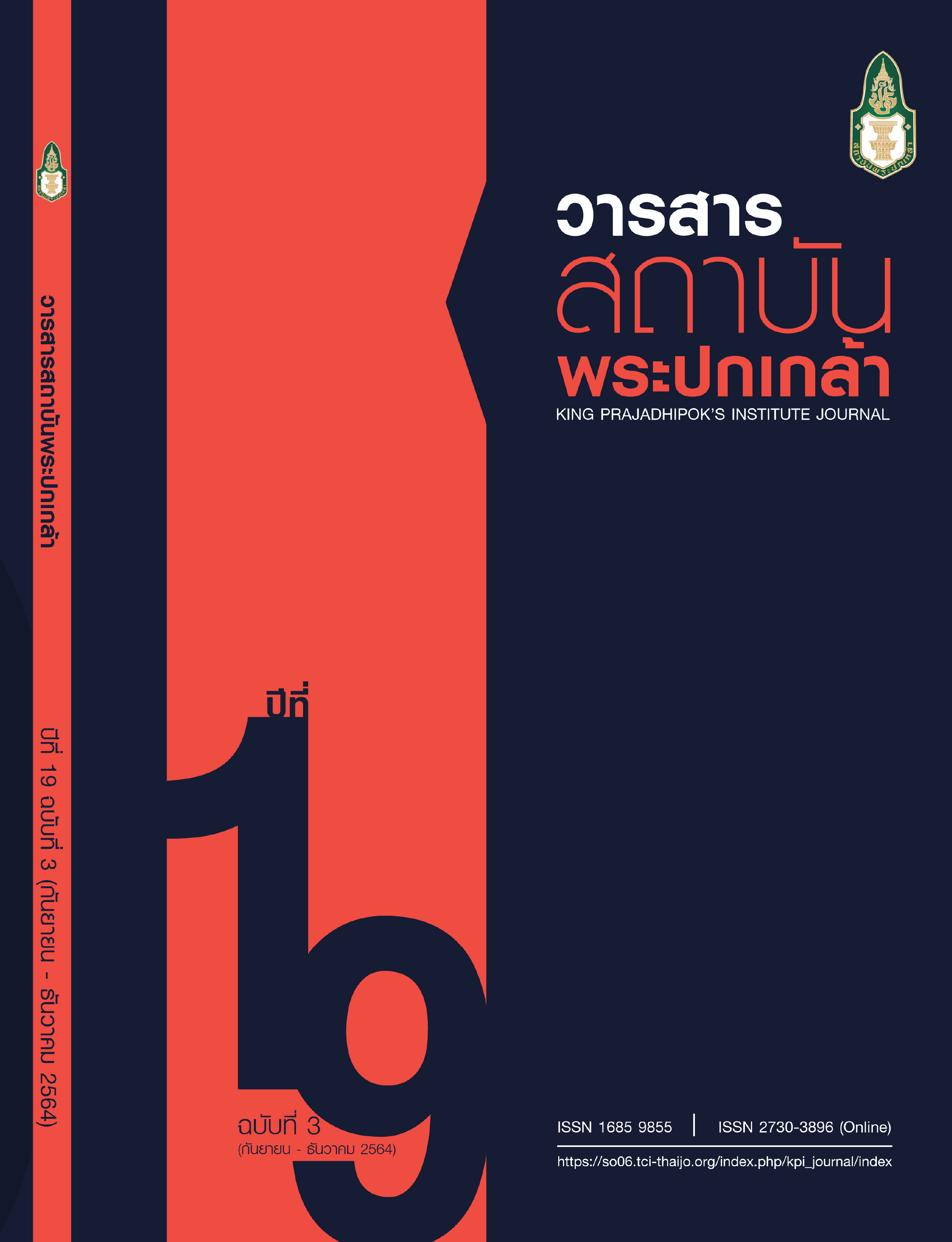A Study of Roles and Guidelines for Enhancement of Performance of the National Human Rights Commission of Thailand According to the Constitution of the Kingdom of Thailand B.E. 2560
Main Article Content
Abstract
This research aims to study the role and operation of The National Human Rights Commission of Thailand (NHRCT), in accordance with the constitution of the kingdom of Thailand to present guidelines for promoting the efficiency of NHRCT operations appropriately. The qualitative research was used in group discussions with 58 persons, located in 5 areas where the coordination center of NHRCT. Analyze data with documentation, content analysis and analytic induction. The result showed that NHRCT was able to perform duties according to various indicators, but faced various problems and limitations from internal factors and they did not cooperate with other agencies. An analysis of the roles and operations of NHRCT revealed that the perception of the roles and operations of NHRCT was relatively low both at the central and local level. People and civil society have little confidence in their work and lack of trust. As for the appropriateness of the NHRCT recruitment process and qualifications, most still agree. However, it should be noted that the origin of the NHRCT is still linked to the people and the stipulated nomination process hinders the people's sector representatives from having the opportunity to be elected. Appropriate approaches to promoting the NHRCT's operational efficiency include amendments to legislation enabling the NHRCT to work more on protecting people's human rights and amend the number and eligibility of NHRCT tenants. A provincial or regional NHRCT office should be established as its own agency and resources should be allocated sufficiently. There must be a selection and development of personnel to work at the local level with access and understanding of the people. Modify the way it works to make people feel easily accessible. The image of the NHRCT has to be improved in its work and NHRCT must work with the media and social media to be a channel to educate and raise awareness of human rights protection. NHRCT's performance must be presented to the public during the year and feedback is provided to the public to help people understand the work process as well as to build more confidence in the NHRCT to the public.
Article Details

This work is licensed under a Creative Commons Attribution-NonCommercial-NoDerivatives 4.0 International License.
@ 2020 King Prajadhipok's Institute The Government Complex Commemorating All Right Reserved.
References
ขจรศักดิ์ บัวระพันธ์. (2554). วิจัยเชิงคุณภาพไม่ยากอย่างที่คิด. นครปฐม: สถาบัน นวัตกรรมการเรียนรู้ มหาวิทยาลัยมหิดล.
คณะกรรมการร่างรัฐธรรมนูญ. (2560). รัฐธรรมนูญแห่งราชอาณาจักรไทย. สำนักการพิมพ์ สำนักงานเลขาธิการสภาผู้แทนราษฎร.
คณะกรรมการสิทธิมนุษยชนแห่งชาติ. (2548). รายงานผลการปฏิบัติงาน คณะกรรมการสิทธิมนุษยชนแห่งชาติ ประจำปีงบประมาณ พ.ศ. 2547. กรุงเทพฯ: สำนักงานคณะกรรมการสิทธิมนุษยชนแห่งชาติ.
คณะกรรมการสิทธิมนุษยชนแห่งชาติ. (2558). รายงานผลการปฏิบัติงาน คณะกรรมการสิทธิมนุษยชนแห่งชาติ ชุดที่สอง. กรุงเทพฯ: สำนักงาน คณะกรรมการสิทธิมนุษยชนแห่งชาติ.
คณะกรรมการสิทธิมนุษยชนแห่งชาติ. (2563). รายงานผลการปฏิบัติงาน คณะกรรมการสิทธิมนุษยชนแห่งชาติ ประจำปีงบประมาณ พ.ศ. 2563. กรุงเทพฯ: สำนักงานคณะกรรมการสิทธิมนุษยชนแห่งชาติ.
โครงการอินเทอร์เน็ตเพื่อกฎหมายประชาชน. (2559). "ยกเครื่องใหม่" คณะกรรมการสิทธิมนุษยชนตามกฎหมายประกอบรัฐธรรมนูญ สืบค้นจาก https://ilaw.or.th/node/4358 เมื่อ 12 ตุลาคม 2562
โครงการอินเทอร์เน็ตเพื่อกฎหมายประชาชน. (2562). การเมืองบนความขัดแย้ง กรรมการสิทธิมนุษยชนบนทางตัน สืบค้นจาก https://ilaw.or.th/node/4358 เมื่อ 12 ตุลาคม 2562
ชนินทร์ อินทรปัญญา. (2561). บทบาทของคณะกรรมการสิทธิมนุษยชนแห่งชาติใน การคุ้มครองศักดิ์ศรีความเป็นมนุษย์ภายใต้วัฒนธรรมทางการเมืองไทย : กรณีศึกษา รายงานผลการตรวจสอบการละเมิดสิทธิมนุษยชน. วิทยานิพนธ์ นิติศาสตรมหาบัณฑิต คณะนิติศาสตร์ จุฬาลงกรณ์มหาวิทยาลัย
นพนิธิ สุริยะ. (2550). คณะกรรมการสิทธิมนุษยชนแห่งชาติ. สารานุกรมรัฐธรรมนูญ แห่งราชอาณาจักรไทย พุทธศักราช 2550. กรุงเทพฯ. สถาบันพระปกเกล้า.
นิยม รัฐอมฤต และคณะ. (2555). การติดตามประเมินผลการปฏิบัติหน้าที่ของ องค์กรอิสระและองค์กรตามรัฐธรรมนูญ. กรุงเทพฯ. สถาบันพระปกเกล้า.
นิยม รัฐอมฤต และ อุดม รัฐอมฤต. (2562). องค์กรอิสระกับการสร้างความสมดุลใน ระบบการเมือง. วารสารสถาบันพระปกเกล้า. 17 (2). พฤษภาคม – สิงหาคม 2562.
บรรเจิด สิงคเนติ. (2560). หลักความเป็นอิสระและหลักความเป็นกลางในการปฏิบัติ หน้าที่ของ กสม.. วารสารวิชาการสิทธิมนุษยชน. 2 (1). มกราคม - มิถุนายน 2560.
บวรศักดิ์ อุวรรณโณ. (2560). กสม. ในความคาดหวัง .วารสารวิชาการสิทธิมนุษยชน. 2 (1). มกราคม - มิถุนายน 2560.
บุญสงค์ ทองอินทร์. (2562). บทวิเคราะห์รัฐธรรมนูญ เรื่อง“รัฐธรรมนูญ : หมวด 12 องค์กรอิสระ (ตอน ที่ 6 คณะกรรมการสิทธิมนุษยชนแห่งชาติ). สืบค้น จาก https://www.senate.go.th/assets/portals/93/fileups/253/
files/Analysis/62/11_62.pdf เมื่อ 7 มกราคม 2563
ภาคภูมิ ฤกขะเมธ. (2556). ปัญหาความซ้ำซ้อนในอำนาจหน้าที่และที่มาของ ผู้บริหารในองค์กรอิสระภายใต้ รัฐธรรมนูญแห่งราชอาณาจักรไทย พุทธศักราช 2550: กรณีผู้ตรวจการแผ่นดินและคณะกรรมการ สิทธิมนุษยชน แห่งชาติ. วารสารสถาบันพระปกเกล้า. 11(1). มกราคม-เมษายน 2556. 92- 115.
รัตนะ บัวสนธ์. (2556). วิจัยเชิงคุณภาพทางการศึกษา (พิมพ์ครั้งที่ 4). กรุงเทพมหานคร: สำนักพิมพ์แห่งจุฬาลงกรณ์มหาวิทยาลัย.
วิษณุ เครืองาม. (2560). แนวทางและความเชื่อมโยงในการดำเนินงานและการ คุ้มครองสิทธิมนุษยชนระหว่าง กสม. องค์กรฝ่ายนิติบัญญัติ องค์กรฝ่าย บริหารและองค์กรฝ่ายตุลาการ.วารสารวิชาการสิทธิมนุษยชน. 2 (1). มกราคม – มิถุนายน 2560.
ศิริลดา ผิวหอม และ พันธ์ทิพย์ จงโกรย. (2562). บทบาทคณะกรรมการสิทธิ มนุษยชนแห่งชาติในการจัดการความขัดแย้งระหว่างชาวบ้านกับโรงงานผลิต แป้งมันสำปะหลังที่ปล่อยน้ำเสียลงสู่คลองพระปรง. วารสารวิจัย มหาวิทยาลัยขอนแก่น (ฉบับบัณฑิตศึกษา) สาขามนุษยศาสตร์และ สังคมศาสตร์. 7(3). กันยายน-ธันวาคม 2562
สถาบันพระปกเกล้า. (2562). ความเชื่อมั่นต่อสถาบันต่าง ๆ และ ความพึงพอใจต่อ การบริการสาธารณะ พ.ศ. 2561 และ สรุปผลการสำรวจ พ.ศ. 2545-2561. กรุงเทพฯ: สถาบันพระปกเกล้า.
สถาบันพระปกเกล้า. (2563). ความเชื่อมั่นต่อสถาบันต่าง ๆ และ ความพึงพอใจต่อ การบริการสาธารณะ พ.ศ. 2562 และ สรุปผลการสำรวจ พ.ศ. 2545-2562. กรุงเทพฯ: สถาบันพระปกเกล้า.
สถาบันพระปกเกล้า. (2564). ความเชื่อมั่นต่อสถาบันต่าง ๆ และ ความพึงพอใจต่อ การบริการสาธารณะ พ.ศ. 2563 และ สรุปผลการสำรวจ พ.ศ. 2545- 2563. กรุงเทพฯ: สถาบันพระปกเกล้า.
สำนักงานคณะกรรมการสิทธิมนุษยชนแห่งชาติ. (2558). ความเป็นมาของ คณะกรรมการสิทธิมนุษยชนแห่งชาติ สืบค้นจาก http://www.nhrc.or.th/AboutUs/The-Commission/Background- and-History.aspx เมื่อ 15 ตุลาคม 2562
สำนักงานคณะกรรมการสิทธิมนุษยชนแห่งชาติ. (2559). หน้าที่และอำนาจของ กรรมการสิทธิฯ โดยสำนักงาน คณะกรรมการ สิทธิมนุษยชนแห่งชาติ สืบค้น จากhttps://www.matichon.co.th/columnists/news_18234 เมื่อ
12 ตุลาคม 2562
สำนักงานคณะกรรมการสิทธิมนุษยชนแห่งชาติ. (2563). คำอธิบายสรุปสาระสำคัญ ของพระราชบัญญัติประกอบรัฐธรรมนูญว่าด้วยคณะกรรมการสิทธิมนุษยชน แห่งชาติ พ.ศ. 2560 สืบค้นจาก
http://www.nhrc.or.th/getattachment/6d6c1adb-4e38-43cf-bd27- d2793d4f0072/.aspx เมื่อ 15 ธันวาคม 2563
สุภางค์ จันทวานิช. (2542). วิธีการวิจัยเชิงคุณภาพ. กรุงเทพมหานคร: โรงพิมพ์แห่ง จุฬาลงกรณ์มหาวิทยาลัย.

